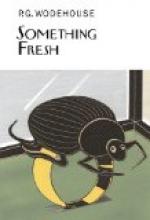There are all sorts of restaurants in London, from the restaurant which makes you fancy you are in Paris to the restaurant which makes you wish you were. There are palaces in Piccadilly, quaint lethal chambers in Soho, and strange food factories in Oxford Street and Tottenham Court Road. There are restaurants which specialize in ptomaine and restaurants which specialize in sinister vegetable messes. But there is only one Simpson’s.
Simpson’s, in the Strand, is unique. Here, if he wishes, the Briton may for the small sum of half a dollar stupefy himself with food. The god of fatted plenty has the place under his protection. Its keynote is solid comfort.
It is a pleasant, soothing, hearty place—a restful temple of food. No strident orchestra forces the diner to bolt beef in ragtime. No long central aisle distracts his attention with its stream of new arrivals. There he sits, alone with his food, while white-robed priests, wheeling their smoking trucks, move to and fro, ever ready with fresh supplies.
All round the room—some at small tables, some at large tables —the worshipers sit, in their eyes that resolute, concentrated look which is the peculiar property of the British luncher, ex-President Roosevelt’s man-eating fish, and the American army worm.
Conversation does not flourish at Simpson’s. Only two of all those present on this occasion showed any disposition toward chattiness. They were Aline Peters and her escort.
“The girl you ought to marry,” Aline was saying, “is Joan Valentine.”
“The girl I am going to marry,” said George Emerson, “is Aline Peters.”
For answer, Aline picked up from the floor beside her an illustrated paper and, having opened it at a page toward the end, handed it across the table.
George Emerson glanced at it disdainfully. There were two photographs on the page. One was of Aline; the other of a heavy, loutish-looking youth, who wore that expression of pained glassiness which Young England always adopts in the face of a camera.
Under one photograph were printed the words: “Miss Aline Peters, who is to marry the Honorable Frederick Threepwood in June”; under the other: “The Honorable Frederick Threepwood, who is to marry Miss Aline Peters in June.” Above the photographs was the legend: “Forthcoming International Wedding. Son of the Earl of Emsworth to marry American heiress.” In one corner of the picture a Cupid, draped in the Stars and Stripes, aimed his bow at the gentleman; in the other another Cupid, clad in a natty Union Jack, was drawing a bead on the lady.
The subeditor had done his work well. He had not been ambiguous. What he intended to convey to the reader was that Miss Aline Peters, of America, was going to marry the Honorable Frederick Threepwood, son of the Earl of Emsworth; and that was exactly the impression the average reader got.
George Emerson, however, was not an average reader. The subeditor’s work did not impress him.




